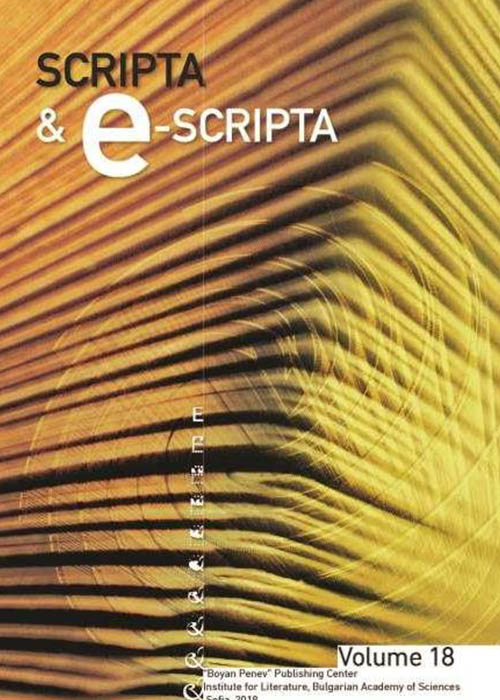(Traces of the Eusebius’ Canonical Tables in Medieval Slavonic Manuscripts of the Four Gospels – Preliminary Notes)
Се ѹбо поѱаннымъ канонѡⷨ скаꙁанїе стаже мъ повѣсть с есть ... (Следите на Евсевиевите канонични таблици в славянски четириевангелия – предварителни бележки)

- Author(s): Axinia Dz ̌urova Vasya Velinova
- Subject(s): Language and Literature Studies // Language studies // Studies of Literature // Philology // Theory of Literature //
-
Published by: Institute for Literature BAS

- Print ISSN: 1312-238X
- Summary/Abstract:
The article is an attempt to answer the question why the so-called Eusebius’ Canon Tables of concordance, widespread in all other linguistic traditions (Greek, Latin, Georgian, Armenian, etc.) are missing in the Slavic four gospels until the 14th century. Glagolitic and Cyrillic codices are considered and special attention is paid to the small number of examples with indications of concordance in the margin, found only in the Codex Zographensis and in two Russian Four Gospels manuscripts from the 15th century. The placement of the concordance in the inner margin of the Glagolitic codex is explained by the influence of the Latin tradition, where this is common practice. The lack of Eusebius’ canons in the Slavonic one is probably a result of the fact that the Slavic translation of the gospel text appeared relatively late, in the second half of the 9th century, when in Byzantium Eusebius’ canons from a tool of hermeneutic analysis gradually became a liturgical marker.
Се ѹбо поѱаннымъ канонѡⷨ скаꙁанїе стаже мъ повѣсть с есть ...
(Следите на Евсевиевите канонични таблици
в славянски четириевангелия – предварителни бележки)
Аксиния Джурова, Вася Велинова
(Център за славяно-византийски проучвания „Проф. Иван Дуйчев“,
София, България)
Статията е опит да се отговори на въпроса защо в славянските четвероевангелия до ХІV в. липсват т. нар. Евсевиеви канонични таблици на конкорданса, широко разпространени във всички други езикови традиции. Разглеждат се глаголически и кирилски кодекси и се обръща специално внимание на малкия брой примери с указания за конкорданс в полетата, открити единствено в Зографското глаголическо четвероевангелие и в две руски четвероевангелия от ХV в. Направен е обстоен преглед на особеностите на византийската традиция. Поместването на цифрите на конкорданса в страничното поле на глаголическия кодекс се обяснява с влиянието на латинската традиция, където това е обичайна практика. Липсата на Евсевиеви канони в славянската вероятно е резултат от факта, че славянският превод на евангелския текст възниква сравнително късно, във втората половина на ІХ в., когато в самата Византия Евсевиевите канони от инструмент на херменевтичен анализ се превръщат постепенно в литургичен маркер.
Journal: Scripta & e-Scripta vol. 20, 2020
-
Page Range: 281-299
No. of Pages: 19
Language: English - LINK CEEOL:
-
Axinia Dz ̌urova(Център за славяно-византийски проучвания „Проф. Иван Дуйчев“, София, БългарияDescription
Prof. Axinia Džurova is a leading specialist in the field of Slavic paleography and codicology and a world-renowned authority in the study of the illumination of medieval Greek and Slavic manuscripts. In a number of her studies she traces the close connection between the Byzantine codex and its Slavic replicas, examines the codicological characteristics of the Glagolitic and Cyrillic codices in view of their typology and their connection with the minuscule and uncial Greek patterns. She participates in the preparation of catalogues of manuscripts from hard-to-reach and unknown collections, publishes a number of valuable samples of the decoration of the medieval manuscript book.
Vasya VelinovaProf., DSc. Ivan Dujčev Centre for Slavo-Byzantine Studies, Sofia St Kliment Okhridski University, BulgariaDescriptionProf. Vasya Velinova is a specialist in the field of Slavic medieval literature (original and translated from Greek), medieval rhetoric and Cyrillic paleography and codicology. She is the author of a number of studies on the literary process in the cultural space of Slavia Orthodoxa, as well as translations of medieval texts. She is also the author of catalogues of Slavic manuscripts.
-
SUBJECT: Language and Literature Studies // Language studies // Studies of Literature // Philology // Theory of Literature //KEYWORDS: Eusebius’ Canon Tables // Codex Zographensis // Gospel lectionary // Tetraevangelion // liturgical function of the manuscripts //
-